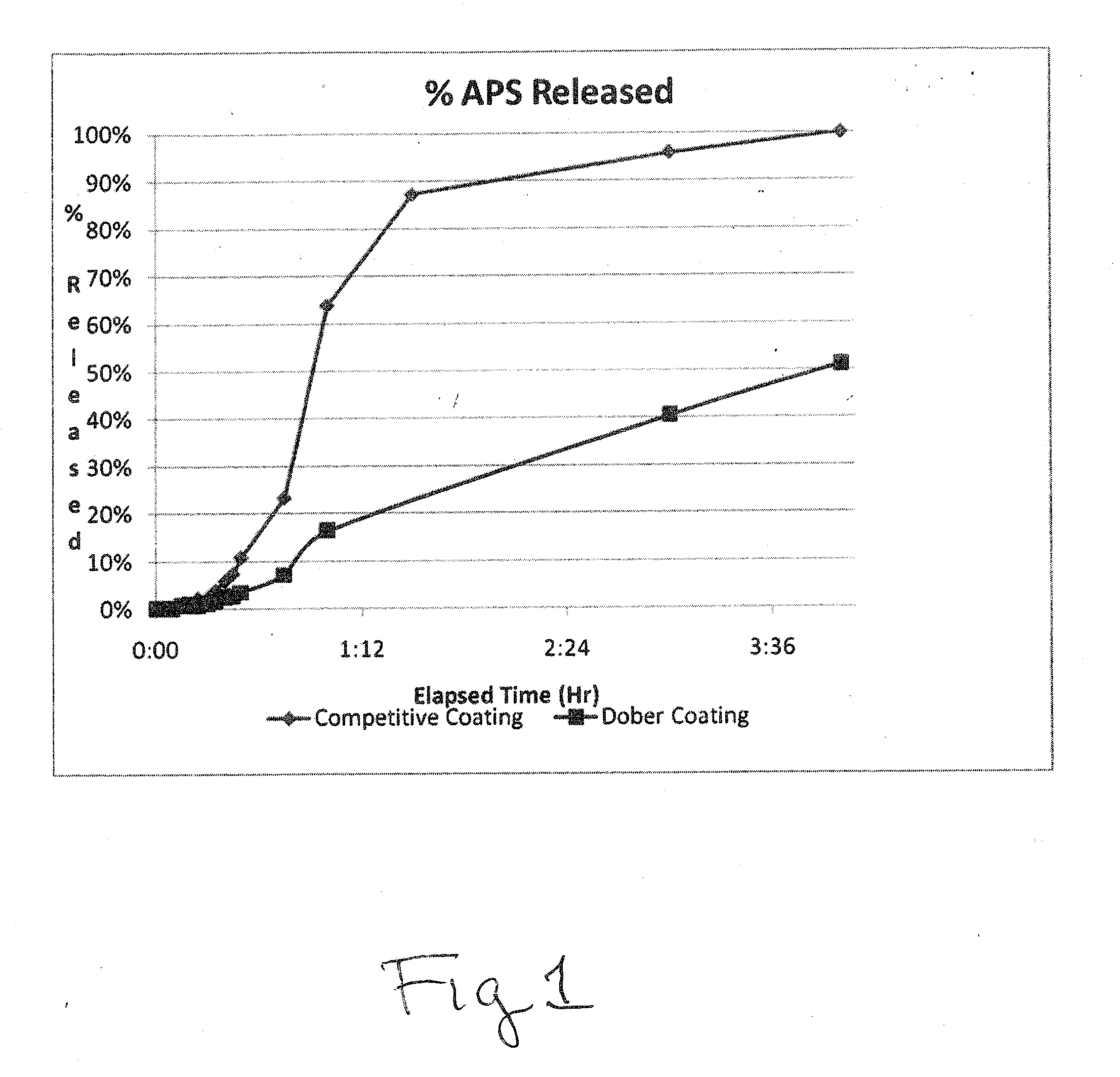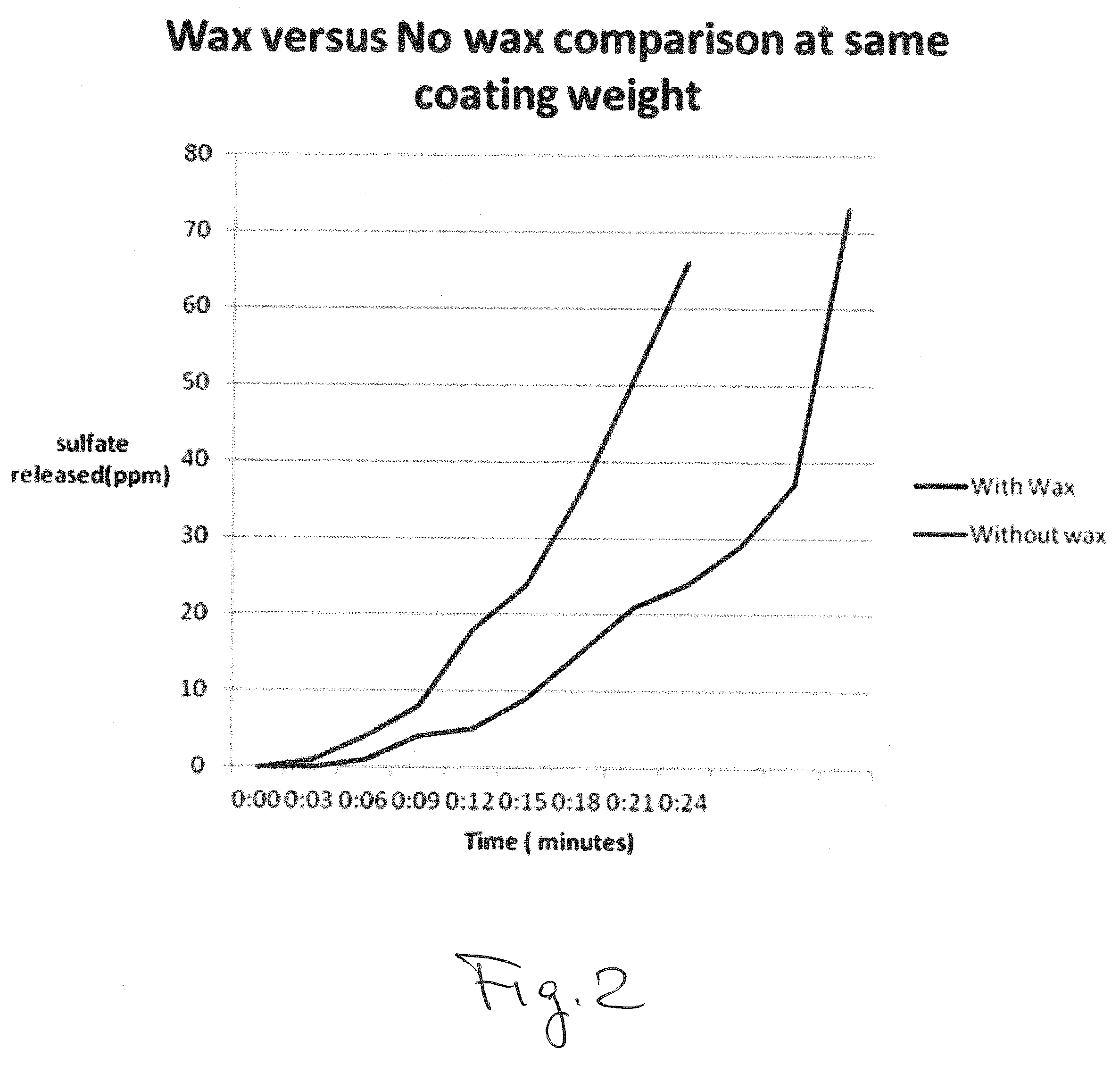Compositions, Systems and Methods for Releasing Additive Components
a technology of additive components and systems, applied in the field of additives, can solve the problems of hydraulic fracturing fluid viscosity reduction, rock or pressure under which the reservoir is subjected may not be great enough, and the rock layer may crack, so as to reduce the viscosity and slow the release of hydraulic fracturing fluid. , the effect of slowing down the diffusion
- Summary
- Abstract
- Description
- Claims
- Application Information
AI Technical Summary
Benefits of technology
Problems solved by technology
Method used
Image
Examples
example 1
[0103]A PW coated APF (where the additive chemical is ammonium persulfate) particle (Sample A) according to the present invention is made as follows: a breaker chemical additive comprises 500 grams of ammonium persulfate particles having a size distribution wherein 42% of the particles have a diameter (or longest dimension) greater than 850 microns, and 58% of the particles have a diameter (or longest dimension) greater than 424 microns. The particles are placed within a bottom spray Wurster coating fluidized bed apparatus (Magna Coater Fluid Bed system, Model 0002 having a 6.7 liter capacity) for coating. Ammonium persulfate is solid and stable at temperatures below about 212° F.
[0104]A coating spray solution is made as follows: a polymer component pre-formulation is first made by combining and thoroughly mixing NeoCAR® 850 with butyl carbitol and water at the weight ratio of 91.7 to 4.2 to 4.1, respectively. This polymer component is then combined and mixed with 1.2% Michem™ Lube ...
example 2
[0111]A 100 lb batch preparation of PW coated APF particles according to the present invention is made as follows:
[0112]A preparation of a PW coating composition is made by combining 3.70 lb of deionized water, 4.0 lb of glycol ether DB (diethylene gycol monobutyl ether), 86.05 lb of Neocar® 850, 5.0 lbs of Michem™ 270R wax emulsion, and 1.25 lb of polyfunctional aziridine PZ-28 (trimethylolpropane tris(2-methyl-1-aziridine propionate) to form a solution. This PW coating composition is loaded into the spray reservoir of the bottom spray Wurster coating device.
[0113]The ammonium persulfate particles (70 lb) are preferably between about 4 and about 100 mesh, more preferably between about 4 and about 50 mesh, more preferably between about 10 and about 50 mesh, even more preferably between about 20 and about 40 mesh.
[0114]79.24 lbs of the liquid net weight of the PW coating composition is loaded into the spray reservoir of the bottom spray Wurster coating device and used to coat 70 lbs ...
example 3
[0116]A comparison is made between the rate of ammonium persulfate release by the PW coated APF ammonium persulfate particles of the present invention (Sample A) and the competitive Gel Breaker 710E particles, purchased from Frack-Chem company (Sample B).
[0117]Each particle preparation were individually assayed for ammonium persulfate release as follows: 1.5 grams of the particle preparation was added to 1 liter of deionized water which had been heated to 170° F. with gentle stirring. Aliquots of 10 mL of each Sample A and Sample B were withdrawn at the time intervals on the x-axis of FIG. 1, and were then analyzed using a Hach sulfate test (Hach PO Box 389, Loveland Colo. 80539) using a DR2800 spectrophotometer. Persulfate decomposes at 170° F. to sulfate ion, which then reacts with BaCl2 (in the Hach sulphate test kit) to form BaSO4, which forms a cloudy precipitate, and can be measured turbidometrically. Thus, the release of ammonium persulfate can be measured by the increase in ...
PUM
| Property | Measurement | Unit |
|---|---|---|
| temperature | aaaaa | aaaaa |
| temperature | aaaaa | aaaaa |
| constant temperature | aaaaa | aaaaa |
Abstract
Description
Claims
Application Information
 Login to View More
Login to View More - R&D
- Intellectual Property
- Life Sciences
- Materials
- Tech Scout
- Unparalleled Data Quality
- Higher Quality Content
- 60% Fewer Hallucinations
Browse by: Latest US Patents, China's latest patents, Technical Efficacy Thesaurus, Application Domain, Technology Topic, Popular Technical Reports.
© 2025 PatSnap. All rights reserved.Legal|Privacy policy|Modern Slavery Act Transparency Statement|Sitemap|About US| Contact US: help@patsnap.com


